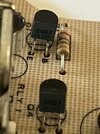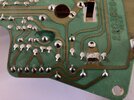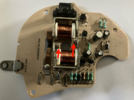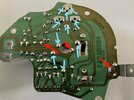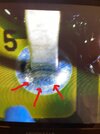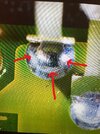Hi,
I am trying to diagnose what is wrong with a controller board for the wiper motor in my 1988 Corvette. Replacements aren't commercially available anymore, hence fixing rather than replacing.
There are four transistors on the board marked '8467' and '727' with what looks like the Motorola logo. The rear of the TO-92 package has three lines painted on it, red, violet and yellow.
Google searches don't seem to turn anything up for these.
Firstly: Does anybody know what these are or what their equivalent is?
Secondly: I am assuming these are a BJT transistor, because the PCB has ECB markings for emitter, collector and base pins. I am assuming a TO-92 packaged MOSFET would not have these markings on the board, instead using SDG? The reason I ask is I attached a simple in-circuit transistor tester to them and it does not indicate a working NPN or PNP transistor. I suspect the probability of all four transistors being dead is low, hence the question about them being something else.
Sorry if these are dumb questions. I don't know that much about electronics.
Thanks in advance.
I am trying to diagnose what is wrong with a controller board for the wiper motor in my 1988 Corvette. Replacements aren't commercially available anymore, hence fixing rather than replacing.
There are four transistors on the board marked '8467' and '727' with what looks like the Motorola logo. The rear of the TO-92 package has three lines painted on it, red, violet and yellow.
Google searches don't seem to turn anything up for these.
Firstly: Does anybody know what these are or what their equivalent is?
Secondly: I am assuming these are a BJT transistor, because the PCB has ECB markings for emitter, collector and base pins. I am assuming a TO-92 packaged MOSFET would not have these markings on the board, instead using SDG? The reason I ask is I attached a simple in-circuit transistor tester to them and it does not indicate a working NPN or PNP transistor. I suspect the probability of all four transistors being dead is low, hence the question about them being something else.
Sorry if these are dumb questions. I don't know that much about electronics.
Thanks in advance.


